What We Can Learn from Other Bear Markets Since the Late Sixties

For US stocks, the price action over the past three months has been quite unlike anything we have seen before. During the course of the recent pandemic many commentators drew comparisons with the Spanish Flu in 1919; however, the reaction of the US stock market was quite different at that time, consisting of a minor drop followed by a rally to new highs. The previous great pandemic came at the end of WWI, a time when the global economic situation was fundamentally different from today. If we cannot derive insight from comparison with the Spanish flu, except to hope that the outbreak will diminish as quickly as its predecessor, then perhaps we may glean some intelligence from a review of the last eight US bear markets.
1968 – 1992
Before looking at each bear market in turn, a quick word about definitions. A bear market is defined as a fall of more than 20% from a previous high, whilst a correction is the description of a decline of between 10% and 20%. Likewise a bull market is declared when a market has rallied more than 20% from its bear market low. For the long-term investor, however, investing at the top of the 1962 to 1968 bull market was a painful experience. The market only reached a new high in November 1992, a full 24 years later. The chart below shows this more graphically: –
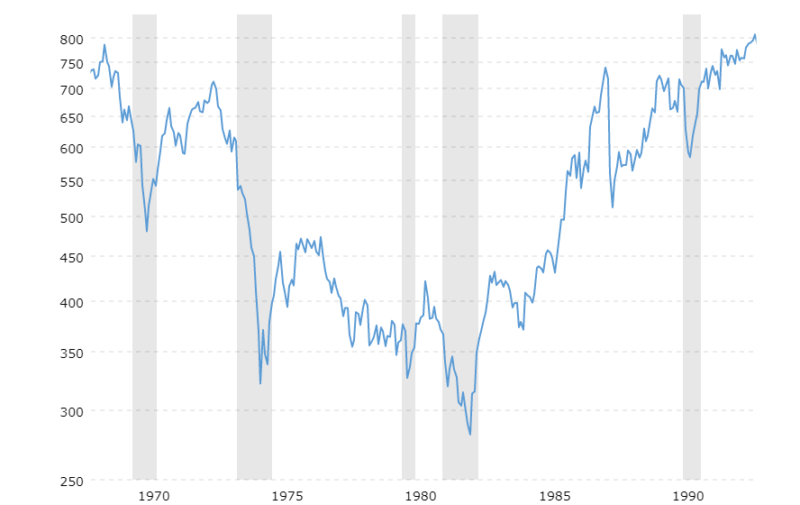
Source: Macrotrends
For those who only recall the 1987 crash it is worth noting that the November 1968 S&P 500 high of 784.92 was above that of August 1987 (739.08). The bear market low of July 1982 was in many ways more profound, as it saw the S&P 500 return to a depth previously plumbed in June of 1954 – 28 years before.
1968 to 1970 – Bretton Woods Breakdown
The 1968 to 1970 bear market evolved in parallel with the gradual collapse of the Bretton Woods agreement on currency rates – the Gold Exchange Standard. The agreement was finally abandoned in 1971, by which time consumer price inflation was evident throughout the developed world. Over the course of the bear market the Federal Reserve (Fed) responded to the price inflation by raising interest rates from 4% to 9%.
1972 to 1974 – First Oil Crisis
The stock market recovery, after foreign exchange rates had been freed from the shackles, proved short-lived and the market declined again as the first oil crisis ensued. Once again the Fed played its part, actively tightening rates from 3.5% to a high of 13%.
1976 to 1980 – First Monetary Squeeze
By 1976 official rates were back down to 5%. A short bull market followed the oil shock, after the Vietnam War drew to a close. Despite very moderate rate increases, the stock market peaked in December 1976. This marked the beginning of a protracted decline, as the Fed began to battle the continued impact of inflationary pressures. Rates peaked at 20% in March 1980.
1980 to 1982 – Second Monetary Squeeze
The US market decline at the end of 1980 was also the result of Fed policy. Between March and June 1980 the Fed Funds Rate fell from 20% to 9.5% – stocks rallied in response. Inflation, however, was far from dead; in June the US CPI index reached an all-time high 13.6%. The Fed waited until August to respond, but by November rates were back to 20%. The chart below shows the S&P 500 index from December 1979 through April 1983: –
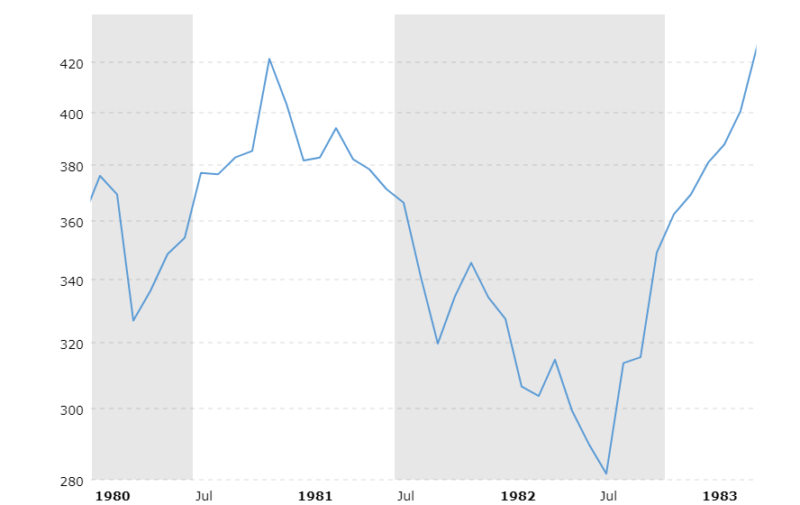
Source: Macrotrends.com
The S&P 500 stock index bottomed in August 1982, and by April 1983 it had reached a new high. Fed rates had again set the tone, closing 1982 at 8.5%. The next chart shows the evolution of the Fed Funds rate over this volatile period: –
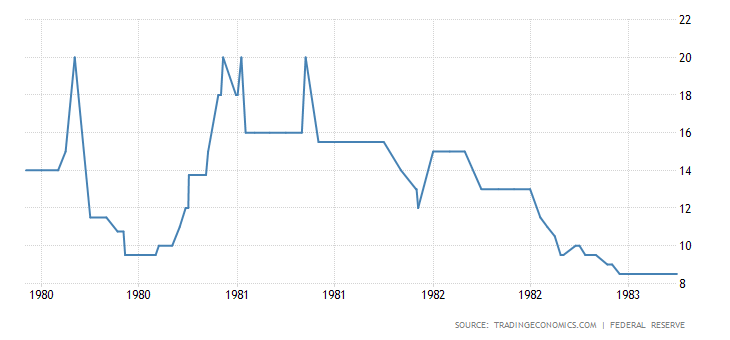
Source: Trading Economics, Federal Reserve
1987 to 1988 – Black Monday
The 1983 – 1987 bull market ended abruptly after tensions in the Middle East reached fever-pitch; Iran fired missiles at oil tankers in the Gulf and the US responded by destroying Iranian oil platforms. Interest rates had bottomed in September 1986 at 5.75%. They subsequently rose to a high of 9.75% by April 1989. The stock market crash of October 1987 saw the newly elected Chairman of the Fed, Alan Greenspan, reverse course abruptly to alleviate the perceived risk of contagion to the wider economy created by the stock market collapse: –
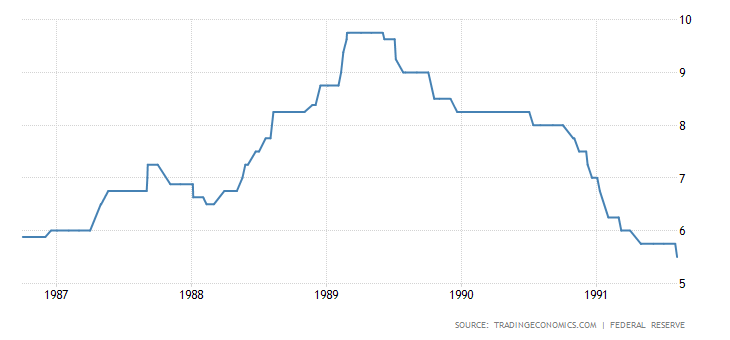
Source: Trading Economics, Federal Reserve
The stock market took time to regain its composure; this was after all the first time a ‘Federal Reserve Put’ had been deployed. In later crises, financial markets would respond more rapidly in expectation that the Fed would save the day.
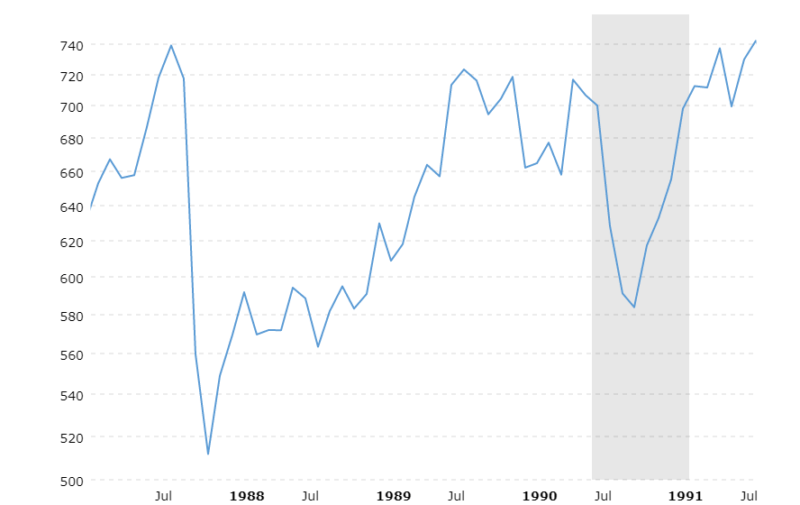
Source: Macrotrends.com
The tentative tightening seen in the spring of 1988 saw the Fed accused of being ‘behind the curve;’ inflation continued to climb. The stock market, however, took the subsequent interest rate rises in its stride. The Berlin Wall came down and countries of the former USSR opened up, re-joining the global economy. A newfound optimism prevailed.
1990 – July to October – The Gulf War
The Gulf War of July 1990 brought the stock market recovery to an abrupt close. The Fed responded to the fall in the S&P 500 by slashing rates from 8.25% to 4% during the next 15 months. By April of that year the S&P 500 index had already taken out the 1990 highs. Once again, interest rate tightening had created the conditions for a bear market correction and a geopolitical event had been the catalyst.
2000 to 2002 – The Dotcom Crash
This bear market was driven by the bursting of the tech bubble. IPO volumes had been unprecedented during the previous two years. Raising capital was easy, and speculation was rife. The market finally peaked in August 2000, fully 10 months after the Fed had begun to increase rates. Once the stock market took fright, rates crumbled, not rising significantly again until the summer of 2004: –
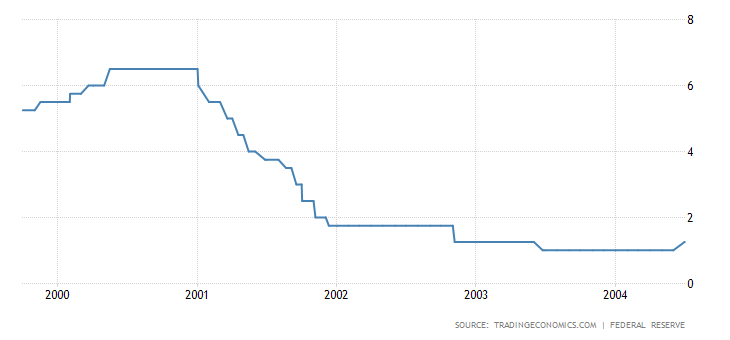
Source: Trading Economics, Federal Reserve
The stock market struggled despite the lowering of interest rates, taking another leg down after the terrorist attacks of September 2001. The 30 month bear market wiped 49.1% from the valuation of the S&P 500: –
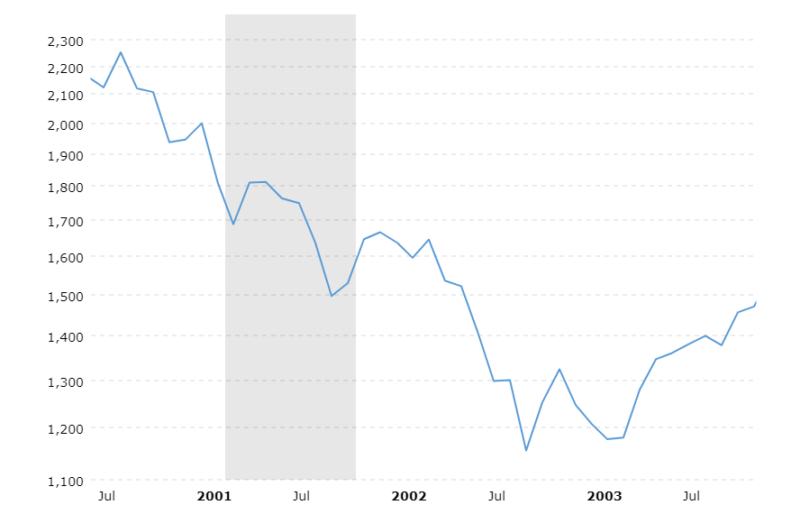
Source: Macrotrends.com
2007 to 2009 – The Global Financial Crisis
The seeds of the largest financial crisis since the Great Depression were sown in the US housing market, but they were aided by the general moderation of inflation when compared to the 1970s ‘80s or ‘90s. Yet again the Fed played their role in ‘removing the punch-bowl;’ sadly they left it too late to ameliorate the excesses of the indiscriminate lending boom which created the conditions for implosion: –
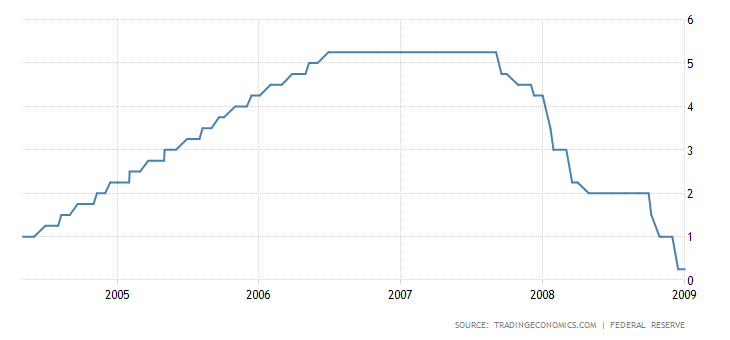
Source: Trading Economics, Federal Reserve
The stock market remained oblivious to mounting evidence of a credit bubble eclipsing even that of the dotcom boom: –
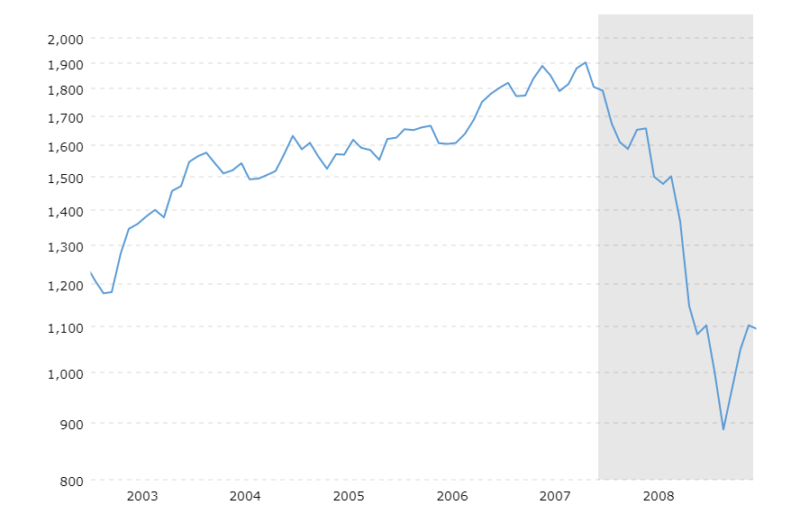
Source: Macrotrends.com
During the latter stages of the housing boom, US lenders ‘fought the Fed’ by relaxing their lending standards and issuing ‘no-doc’ loans. Investment banks, abetted by the ratings agencies, packaged these loans into high grade securities. The financial system finally began to crumble under the weight of low-quality loans masquerading as high-grade securities. Many bankruptcies followed and loan books were eventually sold at distressed prices. The subsequent bear market lasted 17 months, during which time the S&P 500 shed 56.4%.
The Covid bear market and the lessons learned
George Santayana once said, ‘Those who cannot remember the past are condemned to repeat it.’ Looking back at the last eight bear markets, it seems evident that the stock market should never ‘fight the Fed.’ However, it is also clear that every bear market elicits a response from the Fed. In this sense, the 2020 COVID crisis has followed a familiar path: –

After more than nine years at 0.5%, the Fed began to increase interest rates in October 2016. By the end of 2018 they had reached the heady heights of 2.5%, but signs that the global economy was slowing – and an escalating trade war between the US and China – saw a preemptive Fed begin to ease even before the onset of the recent bear market.
The final realization, in February this year, that the COVID-19 pandemic would require a global shutdown, led to an immediate reassessment of corporate profit forecasts. The S&P 500 fell 35.4% in less than a month. The US government, rather than the Fed, was first to render assistance reaching for the fiscal spigot. Not wishing to be accused of ‘fiddling while Rome burned’ the Fed responded, cutting rates from 1.75% to a record low of 0.25% on March 15th. The S&P 500 index subsequently bottomed on March 23rd. It rebounded so rapidly that it had exited the bear market in less than three trading sessions: –
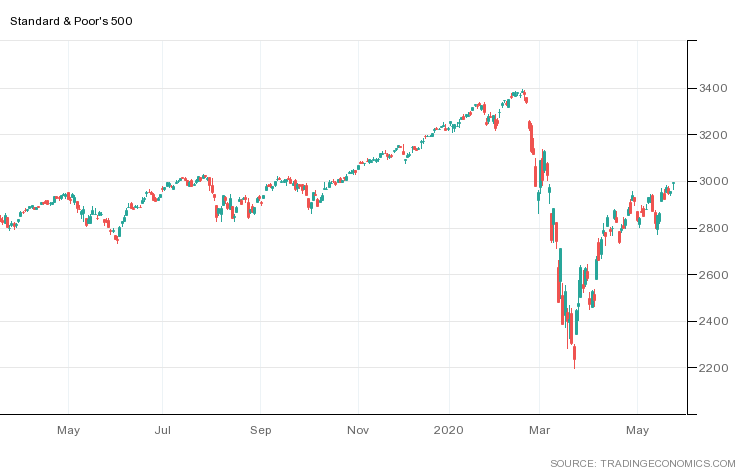
Source: Trading Economics
The lowering of interest rates has helped, but the huge fiscal stimulus has been the differentiator from the eight previous bear market policy responses.
As far as the lessons to be learned are concerned, it is still too early to know for sure. If, as is beginning to become evident, the mortality rate from the COVID virus is lower than was initially anticipated, the global economy may be able to reopen for business quite rapidly. There may also be less risk of a dramatic second wave. Time will tell. Regardless of the longer-term outcome, in the short term many businesses have been irrevocably weakened by this crisis; these businesses will fail to survive. Meanwhile, at the zero-bound, Fed interest rate policy has been rendered impotent.
The effect of artificially lowering interest rates since the 2008/2009 financial crisis has been to postpone the unwinding of malinvestments. The Fed has now declared in favour of ‘yield curve control’ rather than experiment with negative rates. Public companies which can issue debt may find relief as the Fed is bound to purchase poorer and poorer credit. Hopefully, for the sake of sustainable economic growth, this new policy approach will only partially mitigate the long overdue ‘slaughter of the zombies.’
For most of the last decade, ‘Value’ investors have trailed the market as index funds have garnered the lion’s share of assets. Now the environment has changed, and interest rate cuts no longer offer a cheap alternative to assessing value. It took from 1968 to 1992 for the S&P 500 index to rise to a new all-time high. We may be entering a new era where central banks no longer consider it their duty to determine the value of asset markets. The fiscal spigot of government largesse is more arbitrary; it will require a deeper understanding of corporate value to separate the wheat from the chaff. Sadly, markets will be no freer but they may, at least, be untethered from the coattails of the Fed.










